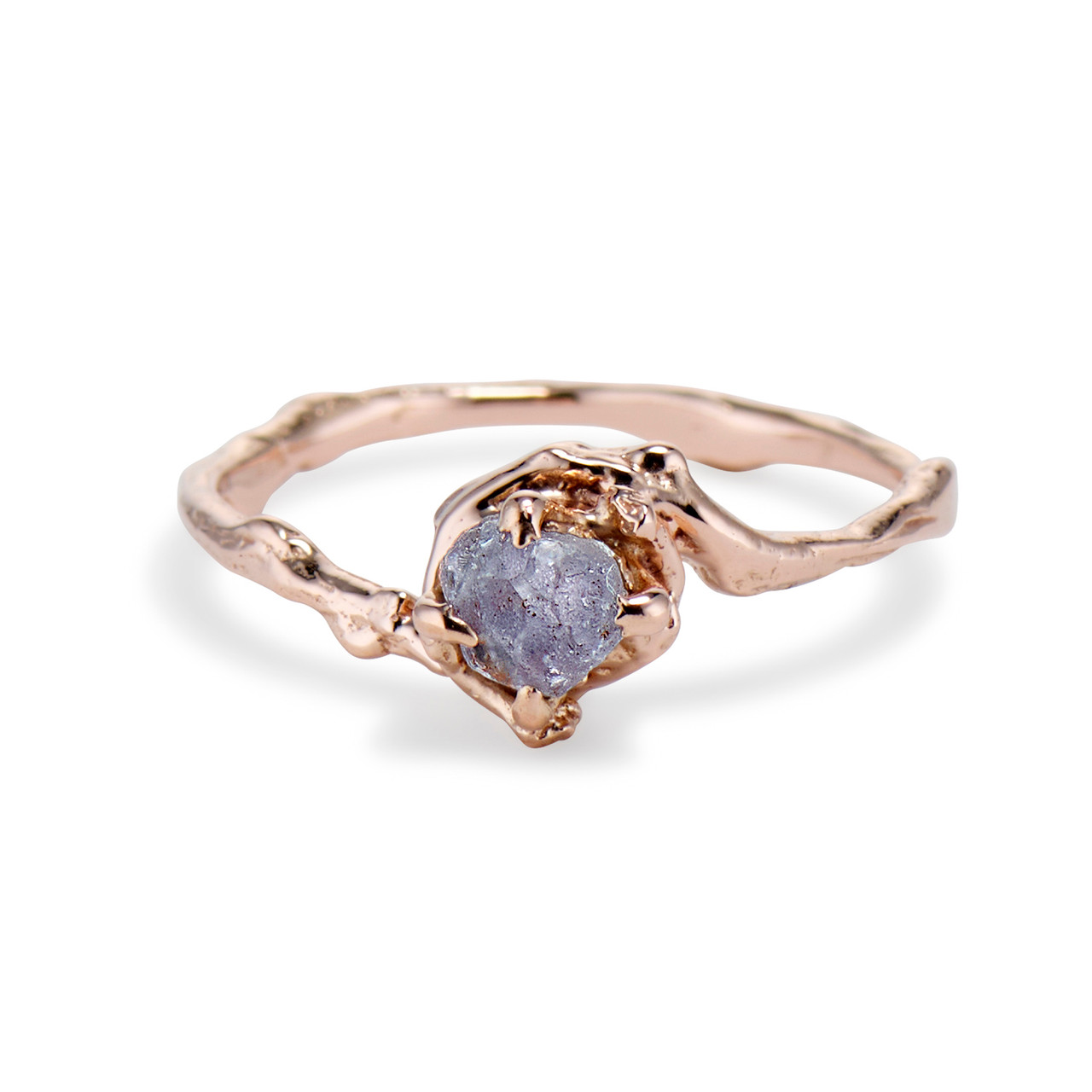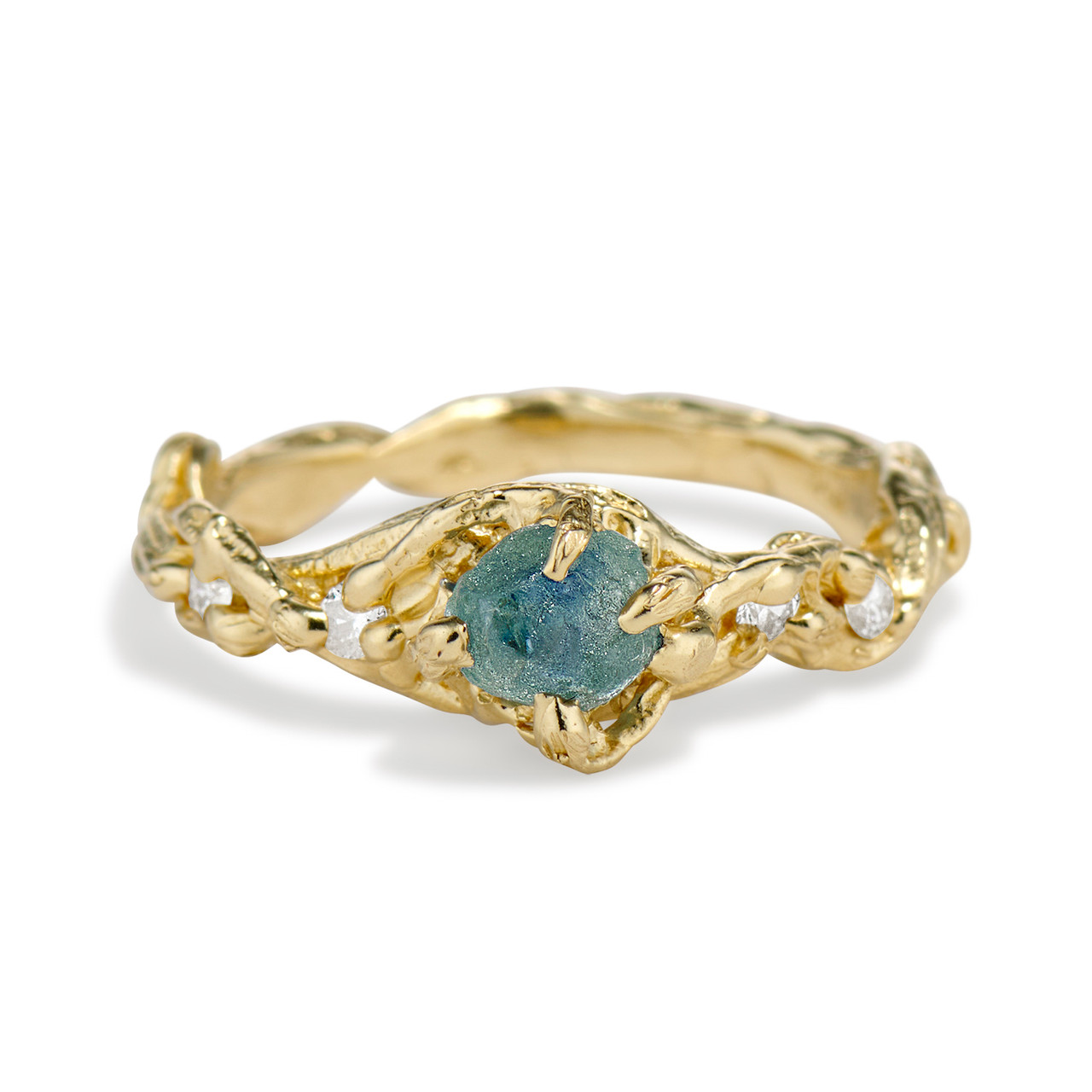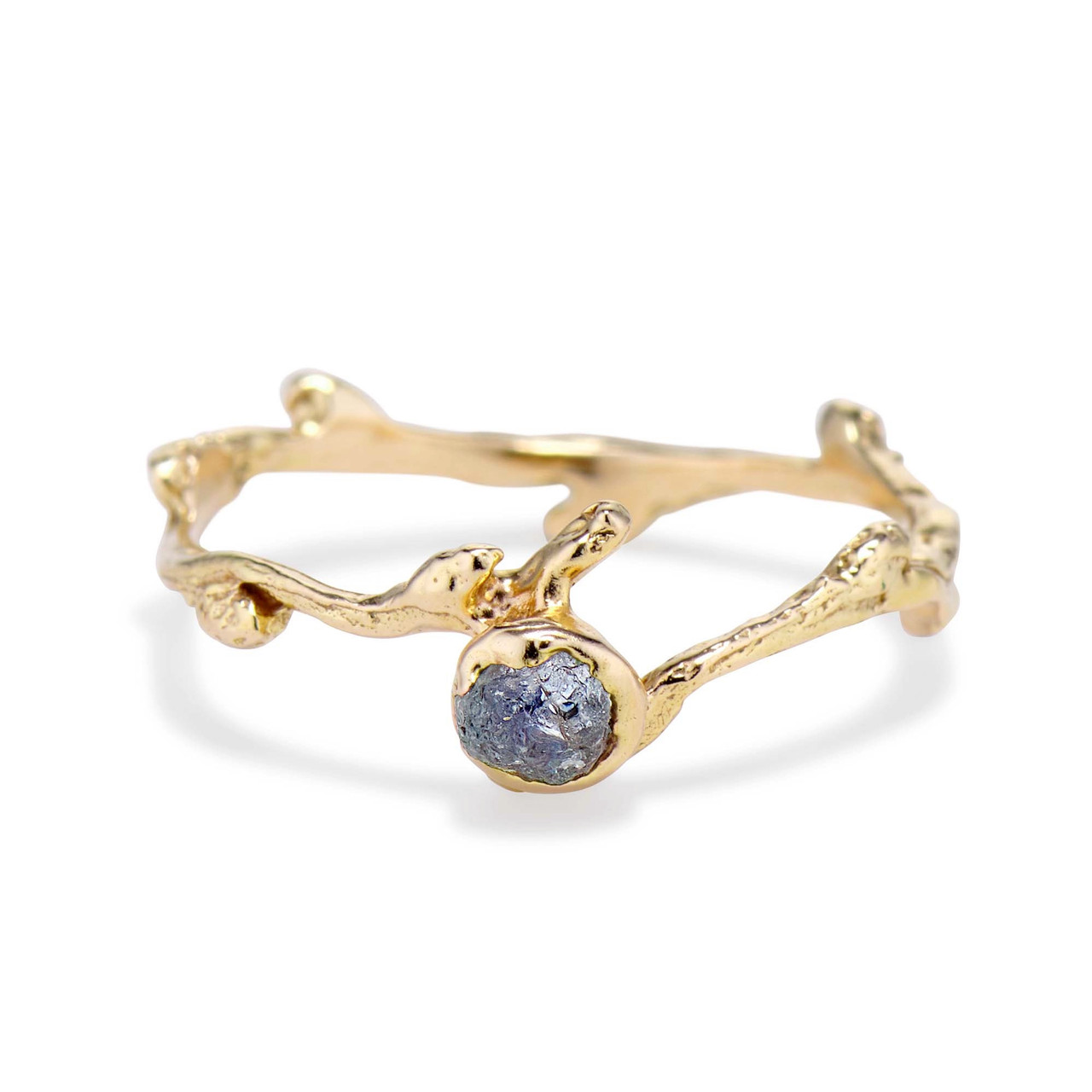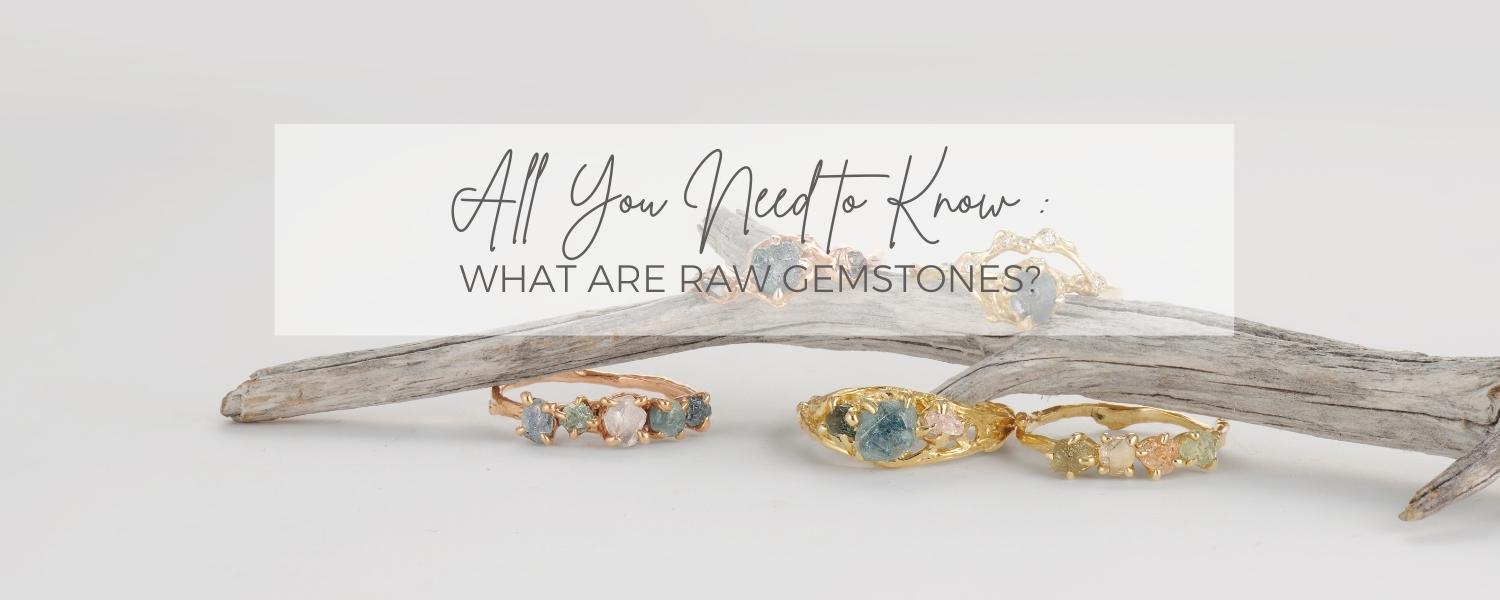Posted by Olivia Ewing on 25th Aug 2022
View Post
ALL OF THE BEAUTY OF THE GEMSTONE AS NATURE INTENDED
Breathtaking in their natural beauty, raw gemstone rings are incredible pieces of fine jewelry that are sure to elicit oohs and ahhs wherever they go. But what exactly is a raw gemstone, what does a raw gemstone look like, and how did it come to be such a popular engagement ring choice? We researched all about this absolutely beautiful ring style for you to find out. But first, let's define what a raw gemstone is and why we refer to it as 'raw' in the first place.
WHAT IS A RAW GEMSTONE?

A raw gemstone is a gemstone that simply has not yet been cut, faceted, or polished. Every gemstone at some point is a raw gemstone. Diamonds for example, when produced in a lab or ethically mined are retrieved in their raw and uncut state. Although diamonds are able to be made in a lab, technology has yet to figure out how to produce a fully cut and polished diamond from carbon seed.
Because all gemstones are, at one point, raw, the sky is truly your limit to collecting raw gemstones. From sunny rose quartz to deep blue sapphire and sea-mist aquamarine, raw gemstones open up a world of beauty.
WHY ARE RAW GEMSTONE RINGS REFERRED TO AS RAW?

A raw gemstone is a piece of uncut, unpolished (raw) rock that has been cut and shaped into a gem. Raw gems are often referred to as “uncut” or “rough,” but this is a misnomer: cut and polished gems are also referred to as raw. So why does the word “raw” get used for both?
The term “raw” describes the state of being unprocessed or unfinished. For example, you might use the term “raw meat” to describe steak that hasn't been cooked yet.
In the case of gemstones, the word "raw" simply refers to a piece of rock that hasn't been cut or polished yet—it's still in its natural state.
DO RAW GEMSTONES GO BY ANY OTHER NAMES?
The most common term to use when referring to an unfaceted gemstone is 'raw'. However, you may also hear them go by 'Rough gemstones', 'uncut', 'unpolished', or 'rugged'. Essentially, anything that screams a little rough around the edges is most likely a raw gemstone.
WHICH IS BETTER: RAW GEMSTONE RINGS OR FACETED RINGS?

Raw gemstone rings prioritize the natural beauty of an uncut gem. The center stone is left unrefined, and the ring itself is polished to a shine. This gives you the best of both worlds—the elegance and sophistication of a traditional ring, with the unique, one-of-a-kind beauty of a raw gem.
If you're looking for something more polished, look for a polished gemstone ring. In this type of jewelry piece, the primary gemstone has been faceted and polished. A polished gemstone ring will draw attention to your favorite stone while maintaining that sense of elegance and sophistication we've come to expect from our jewelry.
DO RAW GEMSTONES UNDERGO ANY SPECIAL TREATMENTS?

Don't be fooled by the rough nature of raw gemstone rings, these stunning jewels are often introduced to special treatments that allow the gem's natural vibrant color to shine through while fortifying its durability.
HEAT TREATING
The most common treatment is heat treating, which is used to improve the hardness and durability of gemstones. This process involves heating the gem with an infrared lamp (this can take up to several hours) and then cooling it in an oil bath (which helps stabilize the stone). Heat treating has been used for centuries and is common for most types of colored gems, such as turquoise, aquamarine, sapphire, amethyst, and more.
IMPREGNATION
Another common treatment is impregnation—which involves injecting a solution into tiny fractures within a stone's structure that have been caused by heat or pressure. This solution contains chemicals that can fill voids and close fractures, making the stone stronger without affecting its appearance or clarity. Often, gems that undergo this treatment can include aquamarine, sapphire, and turquoise.
THE HISTORY OF RAW GEMSTONE RINGS

While it may seem like the only type of ring that has ever existed is a faceted gemstone ring, that is not the case. In fact, raw gemstone rings have been in existence for over six thousand years.
ANCIENT EGYPTIANS
The Ancient Egyptians were known for having a fascination with gold and raw precious stones from an early age. They would wear these items as amulets and charms to protect them from evil spirits and forces. They also believed that wearing these items would give them eternal life in the afterlife. It was this belief system that led them to start creating jewelry made from raw gemstones such as carnelian, jasper, lapis lazuli, hematite, onyx, turquoise, and amethyst among others.
They would often set these stones into rings because they believed they were able to absorb negative energy while keeping positive energy at bay thereby protecting their wearers from harm during their daily activities. This is why many of these rings had crosses carved into them or featured other religious symbols which were believed to keep bad things away while attracting good things towards them at all times during their daily lives
ANCIENT GREEKS AND ROMANS
The Ancient Greeks and Romans valued gemstones for their beauty, their ability to refract light, and their connection to the earth. They believed that the earth was made of many different types of gems and that those gems reflected the different phases of life. The most valuable gems were believed to be those that had been created inside the earth—those that had been formed naturally.
The Greeks and Romans also believed that wearing raw gemstone rings helped them to connect with their gods. They believed that these rings would help them to understand what kind of powers they had within them, and they would also allow the wearer to receive messages from those deities.
In addition, raw gemstone rings were thought to have healing powers because they were considered sacred objects. For example, amethyst was believed to protect against poison and increase strength during times of physical stress such as childbirth or surgery; it also helped people fall asleep easier at night by calming their nerves during stressful situations.
RENAISSANCE RAW GEMSTONE RINGS
The Renaissance was a time of great innovation, and this was especially true for jewelry. During the Renaissance, a raw gemstone ring would often be decorated in arabesque motif details using sophisticated techniques such as enameling, filigree, and repoussé. These techniques were used to create the illusion of depth and movement in the ring.
These techniques were not just decorative; they also served a practical purpose: they protected the wearer from physical harm. The delicate designs allowed for flexibility and movement while still protecting the wearer's finger from getting caught on objects or other people's jewelry.
SEVENTEENTH CENTURY RINGS
In the seventeenth century, jewelers were beginning to cut and facet diamonds by utilizing the rose cut. This cut, which was named after its soft sheen and quick flashes of light, contains 24 facets and a flat base (as opposed to a modern brilliant's pointed base). As a result, faceted diamonds and other gemstones became en vogue and the rough gemstone began to decline in popularity.
FROM THE 18TH CENTURY TO TODAY
It's no secret that faceted gemstones have been the most popular choice for jewelry for decades. But recently, there has been an uptick in demand for rough gemstones.
Part of this is due to a trend toward "raw" materials in fashion and home decor. People want things that look like they were made by hand—not manufactured on a factory floor.
But there's more to it than that: people are also curious about the origin story behind their jewelry pieces. They want to know where each gem came from, how it was formed, and what makes it unique. And fortunately, raw gemstone rings are perfect for just that!
RAW GEMSTONE RING STYLES
MIX AND MATCH ROUGH AND FACETED GEMSTONES

If you can't decide between rough or faceted gemstones why not get both? The Woodland Montana Sapphire Vine Ring features a luminous teal sapphire front and center that is held secure by four prongs. The sapphire is further framed by four brilliant-cut white diamonds that have been cast in place with molten gold or platinum.
This beautiful ring is pulled together with the handcrafted band which was cast from real willow twigs foraged from Brooklyn Botanical Garden and is solid gold. Much like the willow tree itself, the intricate vines of the band delicately dance around the stones, simultaneously complimenting and highlighting them.
SHOP THE WOODLAND MONTANA SAPPHIRE RING
PERSONALISE YOUR RAW GEMSTONE RING WITH YOUR (OR YOUR LOVED ONES) BIRTHSTONES

If you're looking for a ring that's as unique as you are, our Garland Personalized Birthstone ring is perfect.
This handmade ring features four gemstones that you can customize to your heart's content. We have a raw birthstone from every month so if you want to create a stunning ring that pays homage to the people in your life who matter most, the Garland may be the ring for you.
Plus, the Garland band has been hand-sculpted from a real American winterberry holly twig. The twig's natural details have been honored and in doing so the ring retains all of the unique beauty of nature.
SHOP THE GARLAND PERSONALIZED BIRTHSTONE FOUR-STONE RING
MIX IT UP WITH A BEZEL SETTING

If you're looking for a way to secure your stone, prong settings are usually the go-to choice. However, if you're looking for something different and unique, consider a bezel setting instead!
The beauty of a bezel setting is that it gives the illusion that there is no backing at all. It's like putting your stone in a box with an open top, and then surrounding that box with metal. This creates a frame for the stone and makes it look like it's floating or suspended in space.
Our Verona Rough Montana Sapphire Bezel Ring combines the soft femininity of the natural detail of a budded twig with the strong edges of a bezel set raw Montana sapphire. The resulting raw gemstone ring is a perfect representation of your love while honoring the rugged beauty of nature.
FIND YOUR RAW GEMSTONE RING AT OLIVIA EWING JEWELRY
Whether you're looking for turquoise, amethyst, or even diamond rings, raw gemstones are a testament to nature's power. The deep colors and shine from within prove time and time again that there is nothing 'rough' about a rough gemstone.
At Olivia Ewing Jewelry, all of our rough gemstone rings are handcrafted using high-quality and ethical gemstones so you can rest assured that your ring will be as unique as it is beautiful!
SHOP OUR RAW GEMSTONE RINGS TODAY
Meet the Author: Olivia Ewing


